#incredibly self-indulgent i have plans to actually write out the concepts introduced here because i feel. very normal. about them
Explore tagged Tumblr posts
Text
Tell Me So I Say | Read on Ao3
—☾—
The landscape has shifted again.
False doesn’t remember what it was before, lines of white and smears of purple and blue already fading from memory. The harder she tries to hold on, the faster it slips away. Her fist doesn’t listen when she tells it to let go.
Today’s terrain feels as though it’s determined to swallow False whole.
The sky hangs high above False’s head, framed by the lip of the enormous chasm she’s trapped within. Smooth, dark walls make up each side and reach far enough down to hit the bedrock layer and the shallow pool of stagnant water that covers it.
To one side is a city of oranges and whites, neatly contained upon platforms of stone built over the water, separated by the canals that run between each one. To the other is a cylindrical tower that reaches as far upwards as False can see, flanked by covered roads that continue through the semicircle of smaller towers that flank the horizon.
False stands upon a walkway suspended between the tower and the city, gripping the glass handrail hard enough to turn her knuckles white. An uneasiness she can’t name settles along the bottom of her gut; heavy. All is silent save for her heartbeat pounding in her ears.
It’s eerie. Something tingles at the back of False’s neck. She aches for her elytra; some grasping sense of control; anything. Her back remains bare of her wings, as it has for longer than she can recount. For all her time spent here, flying has never worked in False’s dreams.
Initially, she didn’t realize she was dreaming. The real world and her own brain are both confusing enough—who can blame False for the mix-up? A landscape that refuses to remain unchanged; pulsating; restless; hungry. Home is murky liquid slipping through False’s fingers, and her mind is left scrambling for the image it left behind. She can’t wake up—she’s tried, over and over again. No matter what she does, she remains stubbornly asleep.
Being trapped within your own subconscious is a terribly fickle thing.
False walks. What else is there to do? She follows crossing paths down to the city, rows of office buildings and apartment complexes, neon signs advertising non-existent businesses and, inexplicably, a mayoral candidate, to empty streets. Perfectly manicured hedges sit within rectangular planters that line the sidewalks. Every interior behind the white-stained windows False glances into is bare.
False walks until the footpaths become wider roads and the roads lead into the central tower. Looking up at it from the city hadn’t done the tower’s sheer scale justice; False has been shrouded in its long shadow for what feels like forever—time is a logical artifact of the real world; it has no place here—and the sun is entirely invisible behind the tower’s looming silhouette. She steps inside.
If the outside had made False feel small, she feels positively miniscule within it. Sunlight pours through the topmost dome and each of the tall windows that run down the sides of the tower, catching against the glass of each of the higher levels’ balcony railings before hitting the mirrored floor beneath False’s feet; the effect is dizzying. Four different wings, accented by harsh blue lights and soundless water features branch off from the main room. Something about it puts False on edge.
False casts her gaze sharply downwards, a shield against the kaleidoscope above her, an old habit that still clings, and mistakenly catches a glimpse of herself at her feet before flinching away. She doesn’t recognize the stranger in her reflection with features so similar to her own.
Suddenly desperate to be away from the mirror, False strides into the wing closest to her—a pair of elevators. The thought of being confined within such a tiny space sets panic prickling at her palms. The promise of the higher vantage point found on the upper levels leads False to finding a set of emergency stairs and climbing them until the back of her shirt collar is damp and her breaths wheeze from her lungs.
The highest level of the tower is a circular hallway, with doors spaced evenly around the glass-floored center of the room directly beneath the domed roof. Storage rooms filled with strange mechanical parts and offices with desks piled high with mostly indecipherable paperwork blur together as False riles through them. The windows whose ledges she climbs to see through them overlook views of unmoving robots upon bright cyan land; blank hexagonal plates laid out over a calm blue sea. Where is she?
The last of the doors, the one furthest away from the elevators and stairs, is locked. Its mechanism appears to be a surprisingly simple key lock, not at all what False would’ve expected amidst such a space. Curiosity and dread gnaw at her core in equal amounts. She makes quick work of picking the lock open.
The light of the hallway pours into the pitch-black space. False feels for a light switch along the wall; when she flicks it, hanging lights flare to life one by one along the center of the ceiling, casting the room in a cold white. The onslaught of a headache casts its accusing finger behind False’s eyes.
Half-filled shelves line the walls and metal pipes run along the ceiling above them. Empty racks on wheels lay abandoned on the floor in front of a long, stark-white counter. In the back corner is a tube-like chamber, large enough for False to stand in, the last remnants of its glass walls clinging to its copper frame in wicked shards. Leaves of crumpled and torn paper litter every surface of the room. A clock ticks on the far wall.
False doesn’t know what to make of it all. The answer feels so close. Acrid foreboding curdles in her stomach.
She bites her tongue in frustration and approaches a corner of the counter, upon which an askew clipboard rests. With unsteady hands, False picks it up and squints at the shred of paper still caught beneath its clip.
The words are unintelligible, a hasty scrawl written with a heavy hand, but the sliver of blonde hair and pale skin surrounding too-bright blue eyes is unmistakable. False’s face, for once her own, stares back at her.
She drops the clipboard and runs. All but stumbling back down the stairs, she skids across the mirrored floor and sprints blindly for the nearest exit. The clock’s ticking rings in her ears.
False flees back to the hollow city and drops into a crouch in the middle of the road. It’s not familiar yet, but she’ll become acquainted enough with the landscape until it morphs into its next iteration, and then her memory will melt away with it and she won’t have to think about all of this anymore. She’ll sit right here while she waits, away from the tower and its mirrors and its unsettling rooms. It’s not real. It’s not real.
The ticking finds her even down here, echoing through the barren streets, maddingly loud against the silence. False ignores it until she can’t take it anymore. The sound of her boots hitting pavement as she wanders another lap around the city is a blessed respite. By her third loop around the block, something green and impossibly animated on the corner catches False’s eye.
An explosion of foliage blooms in the alleyway between the buildings at the edge of the intersection. Long, curving vines climb the orange and white buildings on either side of the alley. Colorful flowers tucked between lush leaves sway in a breeze False can’t feel, collected around a dirt path that leads up to a silver metal gate, left invitingly ajar.
It’s a trick. It has to be, right? The garden is just something her brain’s thought up and put in place to torture False with some new, fresh horror. It’s not real.
Despite every instinct screaming at her to run, False tentatively takes a step towards it. What’s there to lose at this point, right?
When nothing leaps out of the bushes and attacks her, she inches forwards again. With every step closer, the stillness of the city falls away. The ambrosial freshness of foliage fills False’s senses, and she swears she can hear birdsong. Even False herself changes; when her feet touch the dirt, feeling floods her limbs, connecting them to her body in a way False hadn’t even realized she’d missed. Her vision glows sharper, the world more vivid. The ticking of invisible clocks falls away entirely.
False touches a single hand to the gate. The world goes dark as she’s pulled through.
—☾—
Warmth. The first thing False notices is warmth, beaming down upon her and pooling in the places her skin meets itself. Blinking open bleary eyes, False squints against the sudden, harsh light, and quickly shuts them again. Everything aches.
Awareness comes back to her all at once, and False registers that she’s sprawled on hard ground. Her eyes flare open—ow, right into the sun, that’s what the warmth is—and she almost falls scrambling to her feet, so False settles on sitting upright, digging her fingers into the earth around her. When she brings her hands to her face to pass them over her cheeks, the dirt clings beneath her fingernails.
After giving herself a moment to come fully to, False slowly rises to her feet and takes in the space around her. The path she stands upon is dark dirt, accompanied by wooden steps where the land slopes upwards, continuing on beneath what looks to be a cave, its underbelly leaden with hanging vines and ripe glowberries.
False’s stomach, she realizes with a jolt of shock, grumbles at the thought of them. It’s been so long since she’s felt hungry. Maybe she could investigate the rest of her surroundings and come back to them—who knows what could lurk beyond the vines? She’s not even sure if she’s dreaming anymore.
The cave turns out to be more of an arch, and the other side of it is breathtaking, bursting with bright, undeniable life. Sepia-toned buildings stand proud between fields of wheat and patches of trees that all dance in the same wind that lifts the ends of False’s hair. Low stone walls line the path and contain the fluffy foliage present throughout. A cat perches upon one of the ridges, regarding False with vague interest. There are sunflowers everywhere, all facing towards where she had just come from.
It feels terribly, frighteningly safe. False never wants to leave. It’s not real. It can’t be.
Soft chatter floats through the air, its source a group of people in vibrant shades of green and yellow, laughing as they work near the edge of one of the fields. False freezes. Of all the things she’s had to deal with, people haven’t been one of them. Should she go to them? No, definitely not, right? But they could at least tell her where she is…
Her dilemma is interrupted by the soft crunching of dirt under foot. A playfully musical voice calls out, “You alright there?”
She’s intimidating. The broadness to her shoulders and solidness of her stance speaks to a strength that worries False. She’s beautiful. Golden feathered wings fan out on either side of her, the same color as the petals of the sunflowers that adorn her rich brown hair. Her green dress falls to her knees, and freckles dance across her bare skin. Sweat streaks dirt lines along her forehead as it drips. She feels real.
At False’s lack of response, the woman in green tilts her head. “You’re looking a little heat exhausted there, mate. Can I take you to the tavern for a drink and some rest?”
What does she do, what does she say? Social niceties have never been False’s strong suit, but they fail her completely now. “Um…”
The woman’s brow crinkles with concern. “Do you need a doctor?”
“No! No, I’m alright. Erm.” False wishes she had her elytra. Perhaps a pit conveniently beneath her feet to fall into. “…A drink sounds great, thanks,” she finishes lamely.
Looking unconvinced, the woman shrugs. “Right this way, then. Are you from around here?”
Does False lie? Admit that she’s completely at this woman’s mercy? She decides on, “Not from here, no. I’m a… traveler.”
“A traveler! Well, welcome to Gilded Helianthia, mate. I’m Pearl, and I don’t believe I caught your name?” Pearl starts forward in what False hopes is the direction of the tavern.
“False,” she supplies, falling into tentative step behind her. She’s never heard of Gilded Helianthia, certainly never Pearl. Pearl doesn’t seem particularly inclined to hurt False, at least.
“Nice to meet you, False!” Pearl’s voice is as warm as could be. “It’s nice to have visitors. Tourists tend to go for Mythland, y’know? I don’t blame them, it’s very pretty this time of year.”
“Mythland?” False echoes without meaning to, then winces.
Pearl gives her an odd look. “Mythland? Ruled by King Sausage? Has that whole blood sheep thing going on, but really quite lovely. You really aren’t from around here, are you?”
False gives a nervous laugh. Her head throbs.
Pearl waves a reassuring hand. “No worries at all; nothing wrong with being new! Mythland is a neighboring empire, and one of our allies. Sausage has had some… weird stuff going on lately, but he’s friendly.”
“Got it,” False says, if only to keep moving. Sweat prickles at the back of her neck. Discomfort itches at her gloved palms. Empire?
“Gosh, I’ve been rambling, haven’t I?” Pearl gives a slight shake of her shoulders and picks up her pace.
“No, it’s okay, I like explanations,” False says awkwardly. “Learning how things work… yeah.”
“You do strike me as the type,” Pearl says. “Are you at all interested in magic? Crystal Cliffs’ magic academy will be opening soon, open to all students!”
Magic? False isn’t so sure. “I like… making things. Machinery and such,” she says, hoping Pearl doesn’t take offense.
Pearl brightens. “I get that!” Leaning closer, conspiratorially, she says, “This empire’s rooted in magic, but between you and me, I’ve always preferred getting my hands dirty.”
“Your dress is an interesting choice for that,” False says, the words slipping out before she can stop them.
“I’ve got to look queenly in some regard!” Pearl laughs. “You ought to give The Grimlands a visit at some point. Inventor-types, the lot of them. You with your goggles would fit right in,” she says, her tone teasing but not insincere. False reaches up to touch her goggles. She’d forgotten she has them on.
The conversation flows uncomfortably well between them as they walk. Pearl notes the purpose of each structure as they pass them and in return False tells her a bit about the inventions that sit upon her workbench back in Cogsmeade, trying to ignore the pain in her chest when she speaks of it. In another life, Pearl would’ve been a good ally.
The trek to the tavern is a reasonable one. The tavern itself is a large, inviting building with a wooden sign out front that labels it The Golden Sunflower, its namesake planted by the handful around it. The scent of meat pies and warm pastries that wafts from it fiercely rekindles False’s appetite.
“And finally, that’s the…” Pearl falters, stopping in her tracks entirely. She glances at False, and for a split second, all familiarity falls from her face. False takes a step back.
Pearl opens her mouth as if to speak when her entire form flickers. Her beautiful wings smolder and the end of her dress charrs, scattering ash upon her now-bare feet. Her eyes glow bright; burning. False almost stumbles over her own feet in her hasty retreat, and hits a stone wall hard enough to force all the air from her lungs. The ticking starts anew.
“Pearl?” False hesitantly calls out. She feels like the floor’s disappeared beneath her when she’s only just started to find her footing.
White-hot eyes meet False’s own; it’s hard to hold them. She looks away.
“False. I’m sorry we had to meet under these circumstances,” Pearl says. Her accent is the same, shaping her words into something strong, but her voice almost seems to echo.
“Pearl?” False tries again. She’s not sure what else to say.
“We don’t have much time.” Pearl clasps her hands together. Bewildered, False stays silent. “Listen, False, you’re not as alone as you think you are.”
“What’s that supposed to mean? That’s not comforting, if it’s supposed to be.” It’s a miracle False can hear anything through the damn clocks.
Pearl continues, “You’re stronger than you know.”
How could False be strong? These hands of hers wield a sword she doesn’t remember picking up; her mind is something to be escaped.
“And you’ll make it through, okay?” Something in Pearl’s fiery eyes shifts.
“Through what? Make it through what?” False thinks she may be pleading. The clocks’ relentless drum multiplies.
Pearl draws closer, stopping squarely in front of False. She regards False with a firm line of the mouth and soft set to her eyes. Raising her hands, she places two calloused fingers on each of False’s temples. False finds herself too shocked to move.
“It’s time for you to wake up,” Pearl says gently.
As the world fades into darkness, it changes, lightning-fast: Gilded Helianthia in flames, the sky above shrouded in storms. The rubble’s smoke reduces to wisps and the ruin disappears into the ground, reclaimed by the earth once more as soft green grass and tiny saplings grow tall in the blink of an eye. Right before it all goes black, the ash dissipates from Pearl’s form and the damage to her dress and wings is undone, and False swears the light around her head forms a halo.
—☾—
In her own bed, tucked away in a corner of Cogsmeade, False gasps awake. Morning sunlight pours through the window behind her, and the cat that's been asleep at False’s feet lifts its head and meows. The docked airship outside hums its mechanical tune as the iron farm contained within churns away. False’s headache is a dull throb. The faint scent of sunflowers lingers in the air.
Somewhere deep within the cavern of her empire, a lone clock ticks away.
#my warm-up piece for the week 💪 warning for minor unreality on this one#i feel like i should say i actually love false’s s7 hc base and don’t think it’s lifeless despite the portrayal here. cyperpunk city ily#incredibly self-indulgent i have plans to actually write out the concepts introduced here because i feel. very normal. about them#e!false i miss you forever e!pearl i miss you forever#empires smp#falsesymmetry#pearlescentmoon#wrong planet#empiresblr#my writing
40 notes
·
View notes
Text

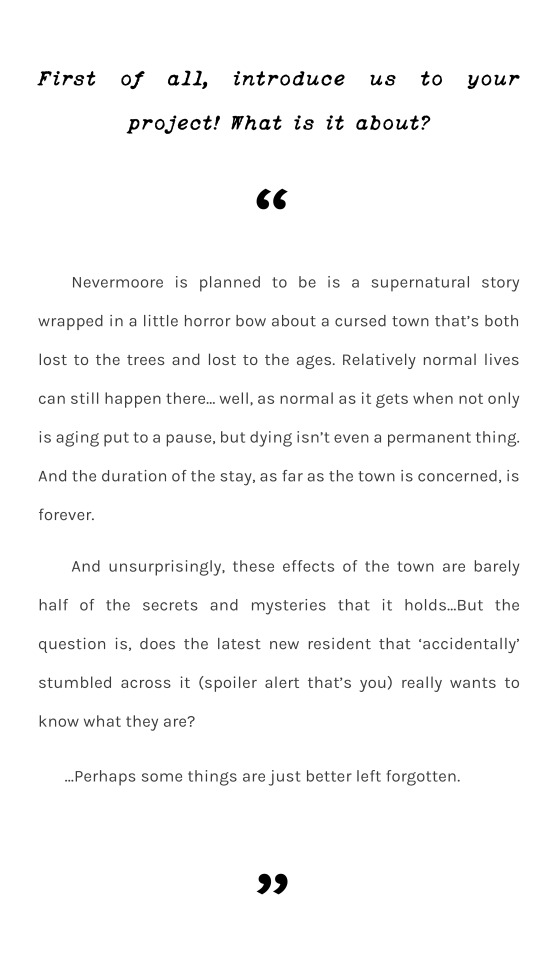

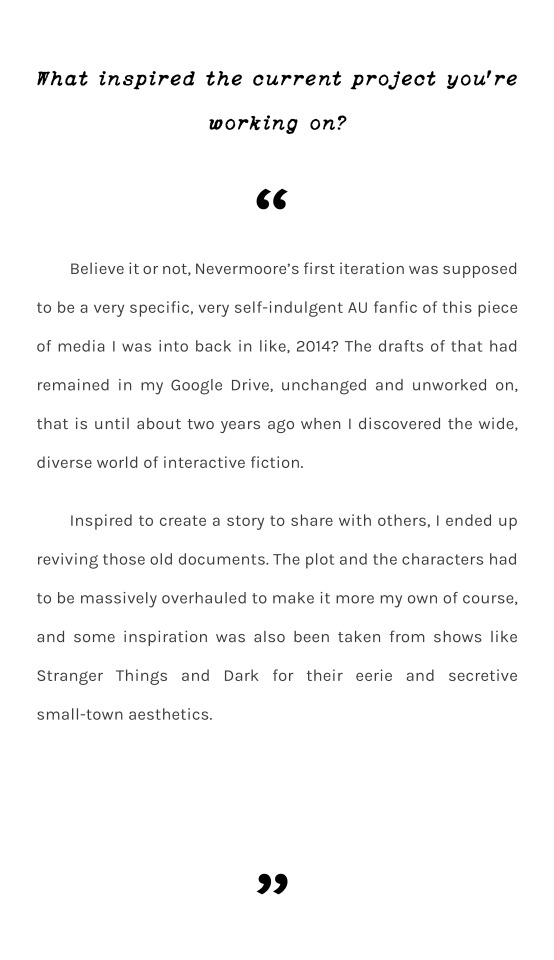
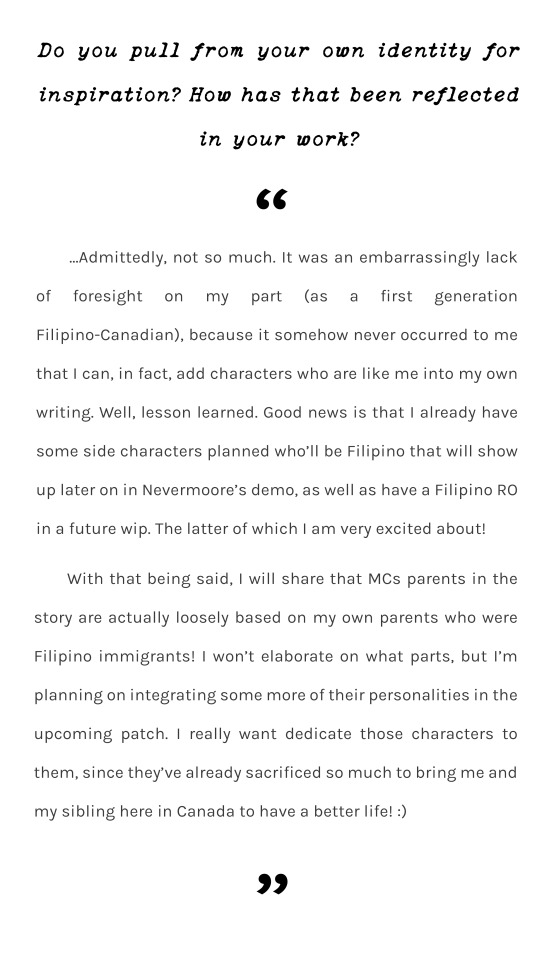
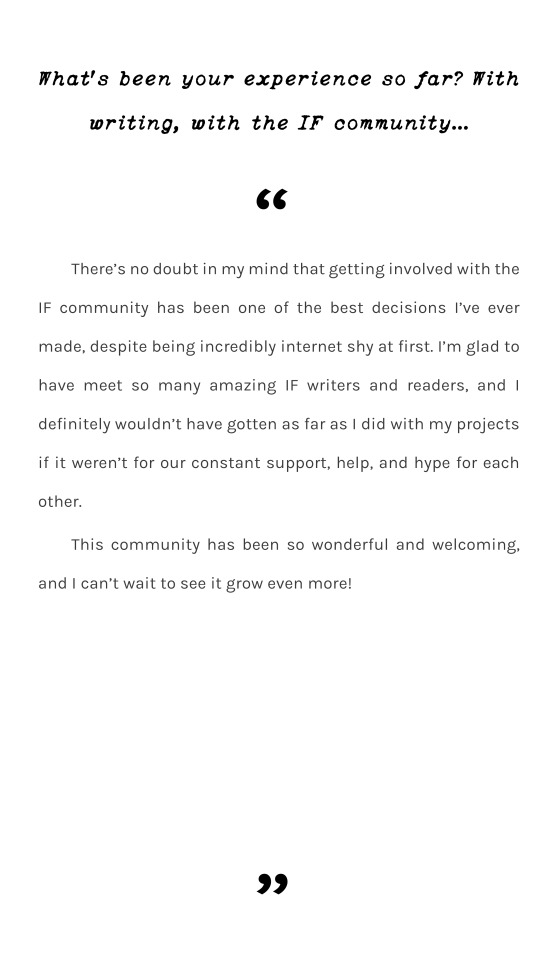
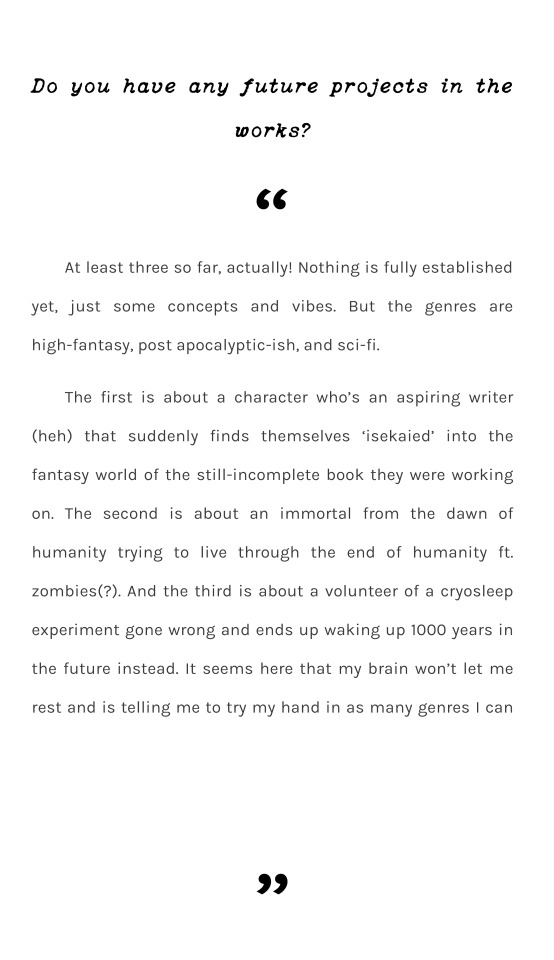
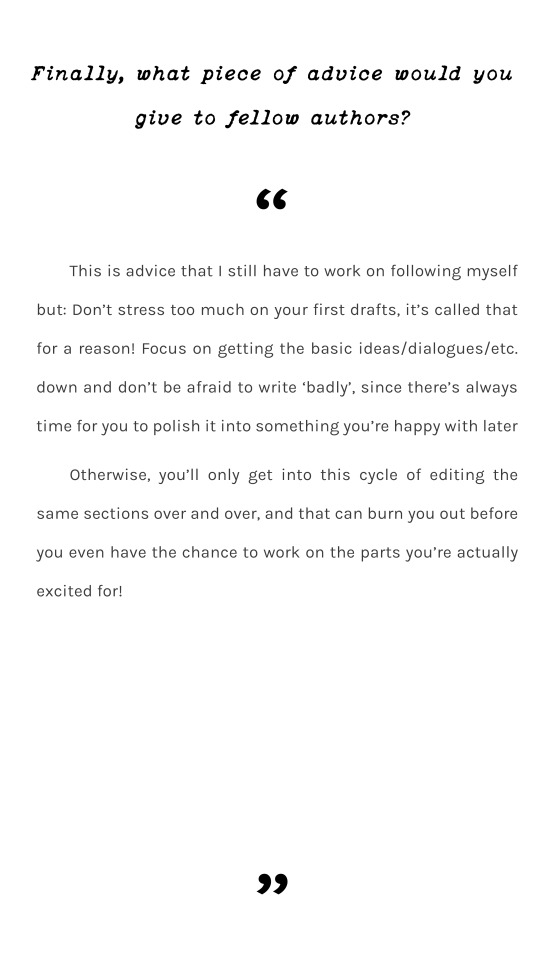
The A/PI Heritage Month interviews are coming to a close soon! For Day 8, we have lovely Aster! :chinhands:
Aster, author of Nevermoore
A/PI Heritage Month Featured Author
They say that curiosity killed the cat, but it won’t be satisfaction that’ll be bringing you back. Again. And again. And again.
The simple act of visiting your parents turns into something much more than what you were expecting when your car suddenly breaks down in the middle of nowhere, and you find yourself right beside a small town that’s engulfed by the trees.
Some of the residents you met right away were welcoming enough, happy to try and lend a helping hand when they can. But their smiles seemed more apologetic than happy, and their eyes looked at you with regret.
You never really did understand why that was…
Until you died.
So now, you are an unwilling participant in an endless cycle of death and resurrection. And the more you learn about the bloodstained history of the town and the past of its people, the more you'll get tangled up in a web of secrets that threatens to keep you there forever.
So welcome, newcomer… to Nevermoore.
(INTERVIEW TRANSCRIPT UNDER THE CUT!)
Q1: First of all, introduce us to your project! What is it about?
Nevermoore is planned to be is a supernatural story wrapped in a little horror bow about a cursed town that’s both lost to the trees and lost to the ages. Relatively normal lives can still happen there...well, as normal as it gets when not only is aging put to a pause, but dying isn’t even a permanent thing. And the duration of the stay, as far as the town is concerned, is forever.
And unsurprisingly, these effects of the town are barely half of the secrets and mysteries that it holds...But the question is, does the latest new resident that ‘accidentally’ stumbled across it (spoiler alert that’s you) really wants to know what they are?
...Perhaps some things are just better left forgotten.
Q2: If it’s not too spoilery, what are you most excited about your project?
Oh, there’s so many scenes and reveals I want to get to already that it’s hard to choose! But if I had to be specific, the one I’m most excited in writing out is Sterling’s (an RO) backstory! I don’t mean to play favorites or anything, but I like to think that their backstory as having the most Hollywood movie levels of drama and intrigue.
Sterling was honestly the first character I made for this story, even before the MC, so I can’t help myself in having some fun with this!
Q3: What inspired the current project you’re working on?
Believe it or not, Nevermoore’s first iteration was supposed to be a very specific, very self-indulgent AU fanfic of this piece of media I was into back in like, 2014? The drafts of that had remained in my Google Drive, unchanged and unworked on, that is until about two years ago when I discovered the wide, diverse world of interactive fiction.
Inspired to create a story to share with others, I ended up reviving those old documents. The plot and the characters had to be massively overhauled to make it more my own of course, and some inspiration was also been taken from shows like Stranger Things and Dark for their eerie and secretive small-town aesthetics.
Q4: Do you pull from your own identity for inspiration? How has that been reflected in your work?
...Admittedly, not so much. It was an embarrassingly lack of foresight on my part (as a first generation Filipino-Canadian), because it somehow never occurred to me that I can, in fact, add characters who are like me into my own writing. Well, lesson learned. Good news is that I already have some side characters planned who’ll be Filipinothat will show up later on in Nevermoore’s demo, as well as have a Filipino RO in a future wip. The latter of which I am very excited about!
With that being said, I will share that MCs parents in the story are actually loosely based on my own parents who were Filipino immigrants! I won’t elaborate on what parts, but I’m planning on integrating some more of their personalities in the upcoming patch. I really want dedicate those characters to them, since they’ve already sacrificed so much to bring me and my sibling here in Canada to have a better life! :)
Q5: What’s been your experience so far? With writing, with the if community...
There’s no doubt in my mind that getting involved with the IF community has been one of the best decisions I’ve ever made, despite being incredibly internet shy at first. I’m glad to have meet so many amazing IF writers and readers, and I definitely wouldn’t have gotten as far as I did with my projects if it weren’t for our constant support, help, and hype for each other.
This community has been so wonderful and welcoming, and I can’t wait to see it grow even more!
Q6: Do you have any future projects in the works?
At least three so far, actually! Nothing is fully established yet, just some concepts and vibes. But the genres are high-fantasy, postapocalyptic-ish, and sci-fi.
The first is about a character who’s an aspiring writer (heh) that suddenly finds themselves ‘isekaied’ into the fantasy world of the still-incomplete book they were working on. The second is about an immortal from the dawn of humanity trying to live through the endof humanity ft. zombies(?). And the third is about a volunteer of a cryosleep experiment gone wrong and ends up waking up 1000 years in the future instead. It seems here that my brain won’t let me rest and is telling me to try my hand in as many genres I can haha!
Q7: Finally, what piece of advice would you give to fellow authors?
This is advice that I still have to work on following myself but: Don’t stress too much on your first drafts, it’s called that for a reason! Focus on getting the basic ideas/dialogues/etc down and don’t be afraid to write ‘badly’, since there’s always time for you to polish it into something you’re happy with later on!
Otherwise, you’ll only get into this cycle of editing the same sections over and over, and that can burn you out before you even have the chance to work on the parts you’re actually excited for!
#if: events#Happy Asian and Pacific Islander month!!#Asian/pacific islander month 2021#a/pi month#a/pi month 2021#aapiheritagemonth#aapi month#interactive fiction#authors of color
126 notes
·
View notes
Text
A SHORT HISTORY OF FEMALE JUDGES IN JUDGE DREDD FROM 2012 TO 2015
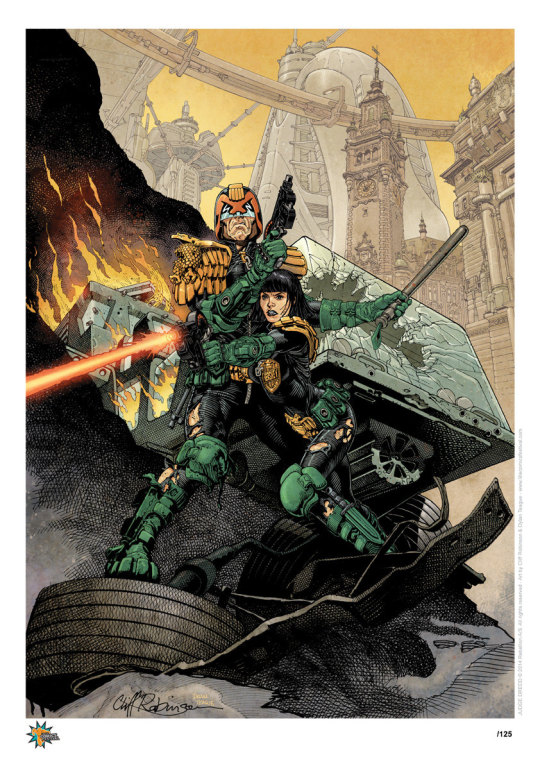
Seemingly satisfied with having thoroughly destroyed Mega-City One and making Dredd horribly responsible for and uncharacteristically powerless during all of it, John Wagner let go of the reins of 2000AD’s flagship character after “Day of Chaos”, leaving the strip in the hands of a new crop of writers who’d waste no time in staking their territory. First with an absolute tour de force of storytelling, and later with epics of their own, filled with supporting casts either handpicked or created by themselves, these writers have carved their own place in the strip by exploring the themes and characters most interesting to each other.
Speaking of characters, the most important development of this era as far as this series is concerned is the return of Judge Hershey to the Chief Judge’s seat. Ostensibly brought back to form an interim administration while the city gets back on its feet, Hershey would end up staying far longer than anticipated, mostly on account of there being nobody else willing and able to take on the monumental responsibility. Least of all, Dredd himself. More on that… right away, actually.
(Previous posts: 1979 to 1982 - 1982 to 1986 - 1986 to 1990 - 1990 to 1993 - 1993 to 1995 - 1995 to 1998 - 1998 to 2001 - 2001 to 2004 - 2004 to 2007 - 2007 to 2009 - 2009 to 2012. Cover art by Cliff Robinson)
We hit the ground running with “Bullet to King Four”, by Al Ewing and Henry Flint (prog 1803, October 2012) a prologue to the year’s first epic. Back in the driver’s seat of a city dangling from a cliff, Chief Judge Hershey is already hard at work. During an interim council meeting that includes Dredd, Judge Stalker and new Wally Squad acting chief Judge Folger (Judge Hollister is mentioned as being MIA, her cover blown during Chaos Day), she reveals her plan to merge Justice Dept’s various units into larger divisions as a way to consolidate their beleaguered forces. She also introduces, to Dredd’s immediate disgust, a new head of Undercover Division and obvious source of future trouble: Judge Carolyn Bachmann.
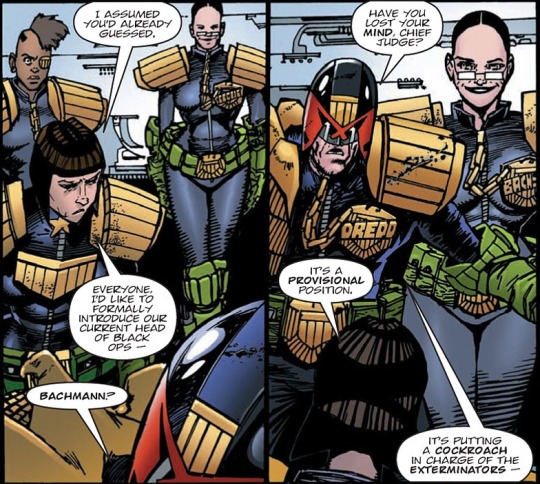
Bachmann had been introduced in a Megazine story set during Tour of Duty called “The Family Man” by Ewing and Leigh Gallagher (Megs 312-313, July 2011), where she was hinted to be the secret head of Justice Dept’s Black Ops Division, introduced years ago in Si Spurrier’s “Dominoes.” An incredibly shrewd, cunning and manipulative woman, Bachmann clashed with Dredd over unsanctioned killings in the mutant townships, but he was ultimately unable to gather enough evidence to go after her in any official way. In fact, during “Bullet…”, Hershey directly references having heard Dredd’s accusations, but stands by her decision to keep Bachmann around. And then we get three of the most savage panels in the history of the strip:
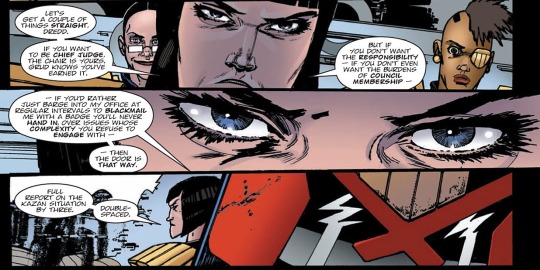
Oof.
Clearly, the good old days of the Dredd/Hershey team are over. Or at least on life support. There’s definitely a lot to be said about Hershey’s words here, starting from the fact that she’s unequivocally, absolutely, 100% right. Dredd has proven, again and again, that he has extremely little patience or desire to deal with the logistical consequences of his decisions. The clearest example of this is back during “Mutants in Mega-City One”, when Dredd arm-twisted his way through the entire Council of Five, but then grew tired with all the politicking he himself started and left them to deliberate it on their own. It was Hershey’s cunning and willingness to stay the course that saved the repeal then.
And then there’s the resignation thing. This is something that Hershey’s not only had to deal with twice (first in “Total War”, then in “Mutants...”), but she was also there when Dredd did resign and eventually came back, during McGruder’s second term. She knows, arguably better than anyone alive, that Dredd is a judge and could never be anything else. What’s interesting is that this time, she doesn’t hesitate to call his bluff. While before, Hershey would’ve been more open to cooperation and second opinions, now she’s stuck doing triage for a half-dead city. And the last thing she needs is Dredd’s constant small picture problems meddling with her attempts at saving what’s left of the big picture, a responsibility that Dredd is staunchly reluctant to take as long as there’s someone else available to do it.
But although Hershey is right in her assessment of Dredd’s mindset, Dredd is likewise right in his assessment of Bachmann’s intentions. In fact, it’s even suggested at the story’s end that Hershey and Bachmann might be working together, which, given Hershey’s penchant for secret operations during her first reign, isn’t entirely unfounded from an in-universe perspective. Par for the strip’s course, nobody is entirely right. But despite the particulars of the story, the key element of “Bullet…” is how it has come to define Dredd and Hershey’s relationship for the last six-odd years.
Following such a strong start, we have “Asleep”, by Rob Williams and Mark Harrison (progs 1804-1805, idem), about a sov sleeper agent being reactivated by accident and gunning for the Chief Judge. The end result is an unabashed Hershey-in-peril scene, complete with her staring down the barrel of a gun on her knees and Dredd saving her life with some quick talking. So bit of a disappointment after the previous story, but hopefully it won’t become a trend or anything. Also of note: yet another redesigned female med-judge.
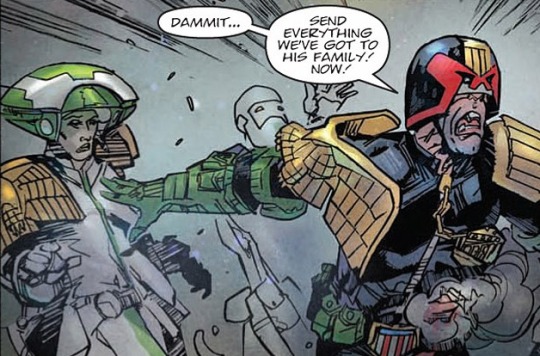
Then we get to the first epic of this new post-Wagner era, “Trifecta”. Which, in my opinion, is one of the strongest and smartest uses of 2000AD’s anthology format in storytelling since “The Dead Man”. Even in collected form it’s still not quite as interesting as it was reading it in the progs, and that’s because it is formed by three different series by three different creative teams that all started independently, and were only revealed to be different parts of a same story one third into it. Now, because I’m a stickler for the self-imposed rules of this series of articles (and certainly not because I’m a lazy bastard), I’ll focus only on the Dredd portion of it: “The Cold Deck”, by the returning team of Ewing and Flint (progs 1806-1811, October-November ‘12).
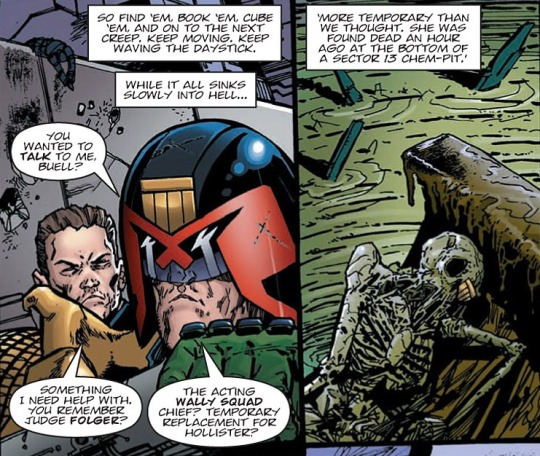
The story starts with the news that Judge Folger has been found dead in rather grisly circumstances, and to make matters worse, she’d also taken an important file from Wally Squad’s computers and erased all copies before dying -- a file so top secret, nobody knows what it is. Dredd suspects Bachmann, and Buell, former head of the SJS, agrees, further suggesting that she’ll use the scandal to prompt a reorganization, strengthen her position and eventually become Chief Judge herself. Which of course, doesn’t sit well with Dredd at all.
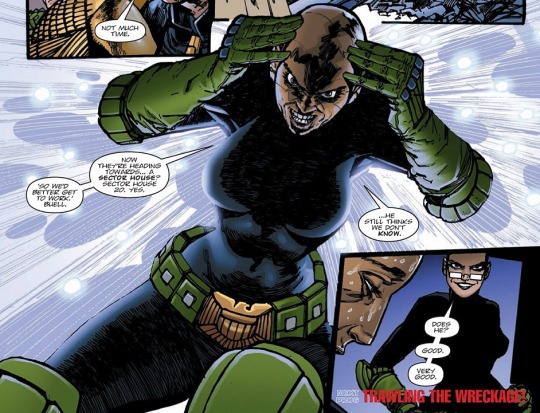
We’re also introduced to Judge Estrella, Bachmann’s partner in crime. A psi-judge, she spends most of the story mentally spying on Dredd on her boss’ behalf. Bachmann is not one to leave anything to chance.
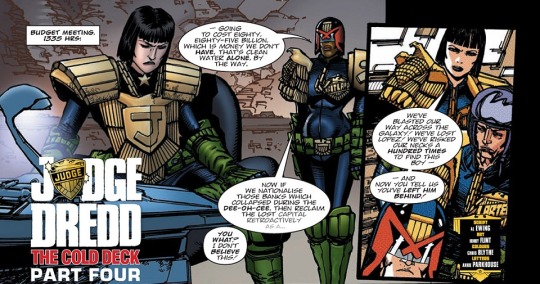
Dredd tracks the file down but intentionally fails to stop it from being sold to someone off-world, where it’s revealed to be a list of every Wally Squad judge in operation. For this, Hershey summons Dredd to her office in an episode that picks right up where “Bullet...” left off, in more ways than one. Opening with Hershey having a flashback to the final pages of “The Judge Child Quest” during a budget meeting with Judge Maitland (who’s also hinted at being part of the epic’s underlying plot), she’s left alone with Dredd. The chapter, set almost entirely from Hershey’s perspective, is an exceptionally sharp bit of writing that segues flawlessly from plot to character development and then right back to plot with notable ease, comfortably aided by Flint peppering the pages with tight close-ups that convey a feeling of claustrophobic closeness between the two judges.
On one hand, we find out that Hershey was fully aware of Bachmann’s underhanded tactics, having made good use of her advice in the past, and wanted her in the Council as a way to get her out in the open and hopefully find something more solid to arrest her for. For the sake of the city, Hershey is willing to give an ambitious spymaster just enough rope to hang herself with, while Dredd would prefer to just hang her himself. But now, both Dredd and Hershey find themselves playing different games but not trusting each other enough to let the other in on them.
And on a deeper level, we get to see the differences between Hershey and Dredd’s conceptions of what it means to be Chief Judge, which is where the flashback comes in. After all, it was Dredd who refused to bring Krysler back to Mega-City One, espousing the notion that the Chief Judge had to be incorruptible. Hershey notes that Dredd idolizes the position of Chief, often leading him to stand in harsh judgment of the men and women who have taken it in the past. Indulging in a bit of armchair psychology, I feel like a lot of it has to do with Dredd’s relationship with the closest he had to a biological father: Judge Fargo, the first and best Chief Judge, against which all others have to be compared. And even if Fargo proved to be more human than it seemed, his myth and Dredd’s indoctrination have created an impossible set of standards in the latter’s mind that nobody else is able to live up to.

But Dredd has never been Chief Judge. Hershey has. Twice. If Dredd knows what the position should be, Hershey knows what it is. And she has no qualms in admitting that it comes with a hefty amount of compromise, subterfuge and even corruption. She laments the loss of her ideals, some of which we’ve been first-hand witnesses to over the years, but still proves to have the good of the city as her ultimate goal at all times. In fact, her attempt at ousting Bachmann is likened to her “victory” over Judge Edgar during her first reign. But in an even more personal level that has very little to do with the current situation, Hershey is shown to be wounded by Dredd’s lack of trust in her, when she trusted him enough to be kicked out of office for him. Dredd’s narrow focus on his vision of what the Chief Judge and the city should be makes him willfully blind to the compromises needed to fulfill it and to the sacrifices others make for believing in him. And Hershey, who has already given everything save her life for him once, is officially through taking his stomm.

And on a personal (for me) note, having such an exceedingly layered, compelling relationship between two estranged former friends without any romantic tension at all is one of the reasons I absolutely love Judge Dredd.
Things escalate pretty quickly after that. Bachmann is forced to execute her plan sooner than expected due to the Wally Squad list being a fake used to lure her out and ruin her scheme to create a shiny new Mega-City reserved for indoctrinated citizens with the assistance of an insane shark-headed (that’s not an euphemism, he literally has a shark’s head) business mogul. Her black ops troops start taking over the Hall of Justice, and she herself beats up and guns Dredd down, but he’s promptly saved by Maitland, who also kills Estrella in the process. This all sets up the stage for the last episode of the epic, the titular “Trifecta”, by Al Ewing, Simon Spurrier, Rob Williams and drawn (gorgeously) by Carl Critchlow (prog 1812, December 2012).
With all the conspiracy and most of the character bits out of the way, the conclusion is a very two-fisted action affair that includes an honest-to-grud flashback cameo by Chief McGruder of all people, a hilariously uncomfortable one-panel reunion between Dredd and Galen DeMarco (who’d been featured in Spurrier’s portion of the story), and one of the all-time greatest Hershey panels:

So with Dredd finally fessing up to knowing about Bachmann’s plans and Hershey admitting that she underestimated their scope, all that’s left is dealing with the mastermind herself. Like any good final boss, Bachmann proceeds to beat the crap out of everyone, including lobbing a stun grenade at Hershey to get her down on all fours which is awkwardly similar to the end of “Sleeper” up there. But in the end, she gets killed from behind by Judge Smiley, a more-secret-than-secret black ops judge who’d been brought in as a countermeasure by Judge Griffin after Cal’s reign, to prevent something like that from ever happening again. Hershey is understandably upset to learn there’s been a presumed-dead spy living in the walls of the Chief Judge’s office for the last 20 years, and berates him for not coming out for any other previous crisis and Dredd for not trusting her. So although the day is saved, it wasn’t without damage, both inside and out.

To Dredd’s credit, however, he’s not a bastard to everyone in this story.
What’s especially notable about “The Cold Deck” is the sheer breadth of roles in display for its female characters. The antagonist, the main side protagonist, the sidekick, the antagonist’s sidekick, even the catalyst for the story itself are all female, plus a handful of background judges in the final chapter. In many ways, this story is the end result of all the past years of development for female judges in the strip. Women encompass all possible roles, from minor to major, from incidental to fully developed, and on both sides of the conflict. By comparison, the other two parts of the story have either no female characters (”Saudade”) or only DeMarco in a very secondary role (”Jokers to the Right”). Meanwhile, the many female characters in "The Cold Deck” are all established characters with different degrees of development, none of which were created for this story except for Estrella. And while it can be argued that it’s astonishingly easy to introduce new characters in Dredd, the fact that a major storyline can encompass such a wide variety of female characters in an organic way still speaks volumes of the people behind it.

After such a whopper story we get a chance to catch our breaths with a Judge Hughes doing sidekick duties in prog 1818’s “Witch’s Promise”, by Alan Grant and David Roach (February 2013) and then it’s right back into the fray with 1820-1822’s “Wolves”, by Michael Caroll and Andrew Currie (idem). The story concerns Dredd and Hershey’s efforts to stop a wave of violence against sov-born citizens after Chaos Day. When things come to a head, Hershey orders all citizens with roots in East-Meg to be taken to a massive internment camp, and then repatriated by the sov block in exchange for much needed food rations, a plan that Dredd is adamantly against. When the citizens refuse to be moved, Dredd proposes relocating them to Mega-City Two instead.
So we can see how Ewing’s character development threads have been picked up by Carroll: Dredd’s increasingly humanistic streak clashes with Hershey’s cold, pragmatic worldview, and in the end it’s Dredd who suggests the solution. At times it reads like a modernized version of much, much older stories where Dredd suggests a straightforward solution to a complicated situation (“Bob’s Law”, anyone?) but I’d argue that the wider context upon which it happens and the decision to let these problems become longer plotlines instead of isolated incidents all conspire to create some annoying quibbles, at least for me. But more on that later.

The story continues in “Cypher”, by Carroll and Iñaki Miranda (1824-1825, March ‘13), where Hershey and Dredd have a meeting with a soviet envoy and his bodyguard, Judge Caterina Pax, to discuss their reneging on the deal. The meeting is almost immediately broken up by a sniper who wounds Hershey and is driven off by Dredd and Pax. With the sov judge’s assistance, Dredd manages to kill the sniper, who turns out to be a cyborg hired by the envoy to kill Hershey for not quite clear reasons, and Pax expresses her desire to defect to MC-1, netting us our first new recurring female judge of this period.
Speaking of new recurring female judges, Psi-Judge Hamida returns in “Suicide Watch”, written by Gordon Rennie and Emma Beeby, and drawn by Paul Davidson (1826-1829, April ‘13). The first Dredd story written by a woman, it features Hamida having a bit of an Anderson/Corey moment, hallucinating a chat with her dead imam over halal hot dogs and feeling the weight of all the dead citizens killed by the Chaos Bug. She links up with Dredd after having a psi-flash, and together they go on the hunt for a potential suicide cult. But things get complicated when Hamida reveals that there’s a jinn -- a supernatural entity who erases people from existence and history behind it, and then even more complicated when Dredd finds out Hamida has been a suicide risk herself since Chaos Day. Ultimately, Hamida perseveres and beats the jinn, saving both Dredd and the day in a rare case of Dredd playing sidekick.

Carroll returns with PJ Holden in tow for “The Forsaken” (1830-1835, June ‘13) which features no less than five female cadet judges, each one with full names and in one case a big secret. Lori Cassano, Madison Echavez, Cheryl Tanuma, Angela Sorvino and Jessica Paris are all part of a group of cadets left for dead after Chaos Day who, feeling abandoned by Justice Dept., made a run for it. The story is told mostly in flashback as Dolman and Dredd track each surviving member, some of which are terribly wounded, and eventually manage to find Paris, who is then revealed to be a clone from Fargo’s DNA strain, effectively making her a female Dredd. Dolman brings her back to the city, with the added complication that she’s carrying the child of one of the other survivors of the incident.
The main hook of “The Forsaken” is getting to see a group of would-be judges giving in to absolute despair, their training falling apart under the strain of an extreme situation and how they form bonds and relationships between each other. While we’ve seen female judges “give in” to their humanity more than once, it rarely comes accompanied by dereliction of duty, and this one has it en masse. Unfortunately, far as I know neither Paris nor her child have appeared again so far, so we’ve yet to see what a fully-fledged female Dredd can look like.
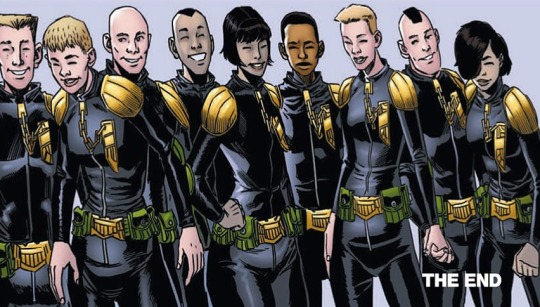
Up next, a Judge Lawadski meets a gory end in Rob Williams and Trevor Hairsine’s “Skulls” (1836, idem) and we check in on Judge Beeny in John Wagner and Dave Taylor’s “Wastelands” (1837-1841, July ‘13). She only makes two short cameos in here, but we find out that she’s been taking a page from Dredd’s book and keeping busy to stop herself from brooding. Interestingly enough, Dredd suggests that she take a break, noting that she’s “going to have to deal with it sometime” and that, if she really wants to change things, she’s going to have to do it “from the inside.”
That last comment in particular is interesting, as it sets up a plotline that Wagner will eventually bring to the Megazine while also staying true to Dredd’s characterization. Dredd, like Beeny, wants Justice Dept to change, but he remains reticent to go in and do it himself. And now that Hershey’s been compromised, he’s putting all his chips on Beeny, making sure that she doesn’t burn herself or become too attached to the streets. Dredd even sugars her up a little, off-handedly noting that she’s one of their best judges. Of course, Wagner being Wagner, this is all conveyed in about eight panels and less than twelve lines of dialogue, all book-ending a completely unrelated plot. In other words, a grand study in character development economy.
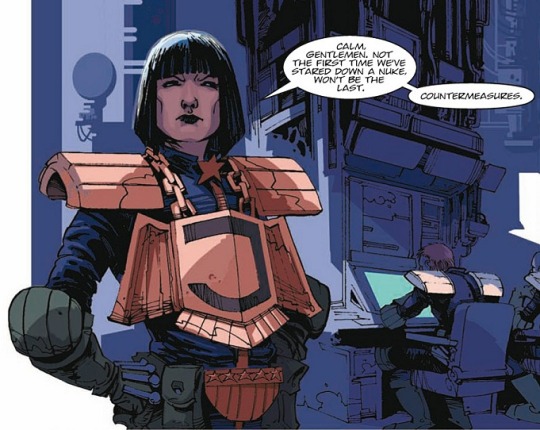
Carl Critchlow comes back to art duties in the Rob Williams-written “Scavengers” (1842-1843, August ’13), which sees Dredd travel underwater to the submerged ruins of Bachmann’s new Mega-City. The story features a Judge Chen who sacrifices herself in a fight against a giant mutated squid in order to keep the mission a secret and also a rather handsome Chief Judge Hershey appearance. We have a Judge Bova in Wagner and Ben Willsher’s “Bender” (1845-1849, September ’13) and Judge Pax returns as one of the stars of Michael Carroll and Paul Davidson’s “New Tricks” (1850-1854, October ’13). After an in-depth screening, she has been allowed to join judges from several other Mega-Cities (including the son of Irish judge Joyce, from “Emerald Isle”) as part of a transfer program to pad out the city’s drained forces.

Pax is shown to be exceedingly competent from the get-go, and the story is even narrated entirely from her journals, through which we learn, among other things, that Dredd seems to have taken a slight shine to her. The main plot involves a Judge Gwendolyn Kilgore, who’s returned from taking the Long Walk into the Undercity to ask for help in taking down a mythical Troggie gang boss called the Goblin King. Fairly standard action strip fare, mostly used to showcase Pax’s skills and to introduce Joyce. But it is certainly interesting to read the former’s thoughts on Dredd and MC-1 in general.
Hershey comes back for another round of workplace awkwardness in “Prey”, by TC Eglington and Karl Richardson (1855-1857, November ’13), although she seems to have grown accustomed enough to crack jokes about it. And that leaves us right at the doorstep of the first of a three-part epic by Rob Williams and Henry Flint: “Titan”.

This first part, which ran from progs 1862 to 1869 (January-February, 2014), kicks off with the news that all contact has been lost with the judges’ penal colony in the eponymous moon of Titan. Without an army to bring any possible rebellions to heel and unwilling to destroy the whole colony before getting all the facts, Hershey sends Dredd and a team of space marines to Titan to recon the place and see what’s going on in there. But after a seriously messed up landing and a couple of betrayals, Dredd finds himself alone and at the mercy of the masterminds behind the convicts’ uprising: former Chief Judge Sinfield, and former Wally Squad Judge Aimee Nixon.
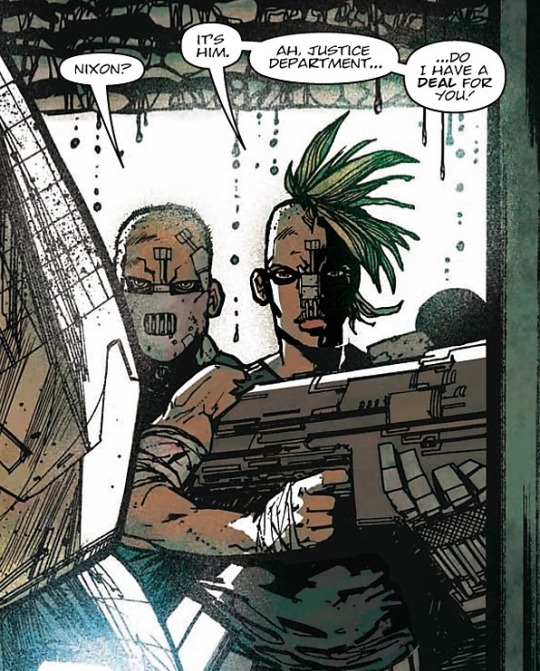
Nixon, of course, was one of the main characters of Williams’ own Low Life serial. An undercover judge on the edge, she eventually quit the department and joined the Hondo City Yakuza in a bid to save her sector from a gang war, but was brought back by her partner, Dirty Frank, and put in an iso-cube for a debriefing, her intel supposedly keeping her safe from Titan. But after Chaos Day, her and several others were shipped there anyway, breaking their deal and leaving her even more embittered and vengeful. Her appearance here is quite the surprise, but makes sense considering the creative team. As Williams’ time became more focused on the main Dredd strip, more characters from Low Life would begin appearing there in guest spots. We’d already seen a hint of that in the last epic.
Back in the plot, once she realizes who she’s got in her hands, Nixon begins negotiating with Hershey. Unlike the last revolt (“Inferno”, all the way back in part four of our retrospective) the inmates here only want to be given Titan as an independent colony. But meanwhile, Nixon has also begun torturing Dredd, trying to break him down to make the man underneath the stoneyface come to the light in hope that his desire for revenge will overcome his loyalty to the law. It’s all a bit “The Killing Joke”, as Nixon seems intent on proving that every judge, even the toughest of them all, hides a human being inside, full of human desires and emotions -- just like she had.
But ultimately, Dredd proves to be too tough a nut to crack, and even when the only survivor of the marines sabotages the colony and Aimee and co are forced to evacuate towards Enceladus, Dredd still refuses to destroy their escape ships, ruining Aimee’s plan to destroy him by making him break the law. The former judges escape, Dredd survives to fight another day, and everything works out alright… for now. Overall, “Titan” is a fairly intense start that goes to some surprising places, but it also does rely a bit too much on a foregone conclusion, which is Dredd not choosing revenge. It’s also pretty funny that this makes it two epics in a row that include a scene of a female judge antagonist arguing with Hershey over a monitor. Wonder if that will be the real trend?
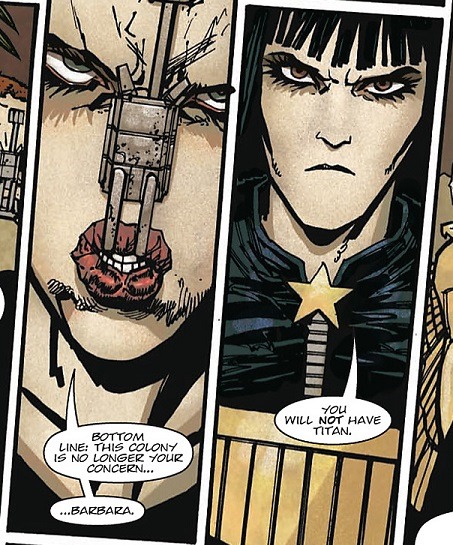
Also of note: Flint seems to have some trouble keeping Hershey’s eye color consistent, since they were blue back in “The Cold Deck.” Or maybe she just has a box of contacts.
We take a breather with a Judge Sisulu side-kicking it up in “Squirm!” (Carroll and Nick Dyer, 1870-1872, February ’14) and then we’re back with Williams and Flint for prog 1873’s “Fit” (March ’14). An epilogue to “Titan”, the story has Hershey send Gerhart, an SJS judge with an axe to grind who was with Dredd during the ill-fated mission, to check on Dredd for any lasting side effects of his experience on the colony. The most interesting part of this one-off for our subject is the very last page, where Gerhart notes that, owing to her history with Dredd, Hershey is ultimately ready to follow him anywhere despite this ongoing cold war between them, which zeroes in on a particular wrinkle in their relationship. For all their mutual posturing and disagreements, ultimately both Dredd and Hershey are fueled by a strong sense of duty towards the city. But while Hershey is worried by its continued day-to-day survival, Dredd is increasingly driven by his vision of a fairer, more human society. In an overly simplified nutshell, Hershey cares about the city, but Dredd cares more about the citizens. And despite her barely being present in it, the next story is one of the strongest examples of this seemingly irreparable schism.
Running in progs 1874-1878 (April ‘14), “Mega-City Confidential” marks the return of John Wagner to the strip, accompanied by Colin MacNeil. A delightfully bleak conspiracy procedural, it ends with the reveal that Justice Department has been taking advantage of the post-Chaos Day rebuilding projects to install covert surveillance equipment in millions of homes, accumulating information that is then parsed by human operators to seek out any signs of criminal activity that may necessitate a not-so-random house search. But when one of those operators escapes and turns whistleblower, Dredd is forced to defend the secrecy of a project he himself had grave misgivings about, calling it “a rare mistake” from Hershey. And once the secret is out, public outcry forces Justice Dept to roll the project back, but not before jailing the operator and probably having the journalist responsible for the leak murdered. Light reading, this ain’t.

That sounds familiar. Also, while not named, this might be Judge Stalker.
On its own, the story works as evidence of Dredd’s growing disgust with the dehumanization inherent to the judicial system, and his own discomfort as a cog within a machinery that seems increasingly prone to falling into these excesses. As such, Hershey’s error of judgment is mostly an afterthought, but I do find it’s interesting to put it within context. The Chaos Bug attack, for example, relied heavily on privacy and subterfuge, so it’s easy to see why Hershey, who’s trying to keep a dying city alive, would be tempted to go forward with something -- anything that could prevent something like that from happening again. It’s a steep change from when Hershey was considered the most liberal of all the candidates for Chief Judge, but makes sense given her own personal development and the circumstances of her return to the position. As she’s grown older and her situation direr, she seems much more open to sacrificing the liberties she used to champion for the sake of keeping people alive. So in a way, her character development has taken on a polar opposite route to Dredd’s.
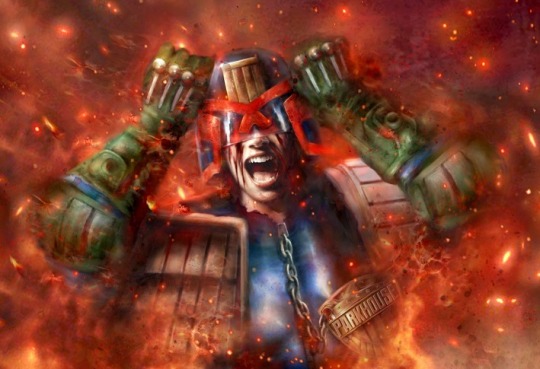
Wagner stays a little longer for “Shooters Night” (art by John McRea, 1879-1882, May ‘14), which nets us an unnamed female judge and a small Hershey cameo at the end. Then Carroll returns with Nick Percival for “Traumatown” (1883-1887, June ‘14), a story about Dredd being haunted by a near-dead Psi’s vengeful spirit that features a veritable cavalcade of female judges: Pax and Hershey guest star alongside new Psi-Judge Lewis, and there’s even a funny little cameo by a Judge Parkhouse, clearly named after long-time 2000AD letterer and unsung heroine Annie Parkhouse. After that blowout, we get a small med-judge appearance in 1890-1891’s “Student Bodies” (Wagner and Boo Cook, July ‘14) and a new crisis for Dredd and Hershey in “Cascade” (Carroll and Paul Marshall, 1894-1899, August-September ‘14) as the Lawlords, a race of brutal alien overseers whom Dredd had already faced in a previous story, attempt to take over the city. The story features a Judge Reyer who dies trying to stop the attack early on, and unfortunately, Hershey’s role in it is mostly just glowering a lot while Dredd saves the day as usual.

Up next we have the return of Judge Beeny in Wagner and Carlos Ezquerra’s “Block Judge” (1900-1909, September-November ’14), where she assists Dredd in bringing a troublesome block to heel. But although it’s great to check on her progress as a judge, there isn’t much character development to be found here, and it’d seem Beeny is on the track to becoming another Dredd sidekick template. Wagner, however, has bigger plans for her, although as mentioned before, the big turn will happen in the Megazine.
The story also has a couple of guest appearances from Hershey, as Dredd for once acts very tactfully around her, asking for her help in keeping a couple of crime lords locked up for incredibly petty crimes until they can uncover more evidence. As usual, a common enemy does seem to unite them well enough, although Hershey can’t resist calling Dredd out a little on his criticisms. But for a moment, the old team is back together, with Hershey making sure Dredd is able to do his job as effectively as possible.
Another nameless female judge shows up in Alec Worley and Leigh Gallagher’s “End of the Road” (1911, December ’14) and the year closes with a return appearance by Judge Lewis in Carroll and Karl Richardson’s “The Ghost of Christmas Present” (prog 2015, idem). And if things sound like they’re finally settling down a little, don’t worry, because our last stop of this post features the biggest return of them all...

“Dark Justice” (progs 2015-1921, January-March 2015) was famously born out of artist Greg Staples’ desire to paint a classic Dark Judges story. And although John Wagner had admitted to basically having run out of ideas for them, he was happy to go back in after seeing Staples’ test sketches. The end result is a visually stunning mini-epic with an otherwise fairly standard plot, as Dredd and Psi-Judge Anderson team-up to hunt down Judge Death and his pals onboard a deep space colony ship. Not much to say character-wise about this one, as both Dredd and Anderson seem to revert back to their early 80s action hero selves, filling the story with wisecracks and one-liners as they batter the fearsome foursome. Anderson does get to shine pretty brightly on this one, pulling Judge Fire’s spirit out of Dredd’s mind and revealing that her past experiences with Judge Death have allowed her to develop a slight immunity to his powers. In the end, the superfiends are ejected and left drifting in space while our heroes await a rescue, and there’s not really much else to say.
One thing that is noteworthy is that Staples used model and cosplayer Lauren Integra Fairbrook as his model for Anderson in “Dark Justice”. Which makes sense, considering she’s the official Anderson model for Planet Replicas and has featured in the Judge Minty and Strontium Dog: Search/Destroy fan shorts. In fact, there’s even a reference to an “Lauren Integra Cosplay Ground” in “Mask of Anarchy”, a previous Dredd story.

And as an extra bit of trivia, Planet Replicas’ official Dredd model is… Greg Staples himself.
In our next episode: two epics! Two thousand progs! And... The End?
#2000AD#Judge Dredd#Female Judges#Al Ewing#Henry Flint#Rob Williams#Mark Harrison#Carl Critchlow#Michael Carroll#Andrew Currie#Iñaki Miranda#Paul Davidson#PJ Holden#John Wagner#Colin MacNeil#Nick Percival#Paul Marshall#Greg Staples#Lauren Integra Fairbrook#Judge Hershey#Judge Bachmann#Judge Hamida#Judge Maitland#Judge Pax#Aimee Nixon#Judge Anderson
34 notes
·
View notes